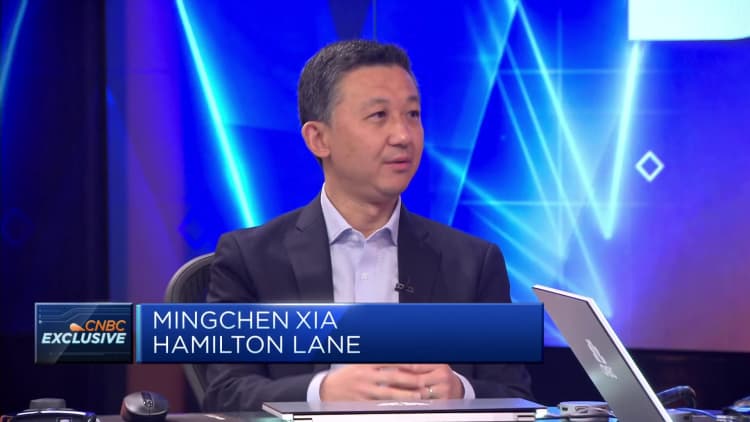Pictured here is Shenzhen in southern China. The city is sometimes considered China’s Silicon Valley.
Nurphoto | Nurphoto | Getty Images
BEIJING — In the years since Alibaba’s U.S. listing in 2014, early-stage investing has drawn tens of billions of dollars into China with relatively little to show for it.
Among China-focused investment firms, only four U.S. dollar-denominated venture capital funds established between 2015 and 2020 have at least returned investors all the money they put in.
That’s according to a new report “China’s Private Capital Landscape” from Preqin, an alternative assets research firm. Alternative assets include venture capital, but not publicly traded stocks and bonds.
Preqin looked at an industry metric called distributed paid-in capital (DPI) and listed the 10 funds in the category with the highest DPI.
The other six have yet to give investors back all their money, not to mention any excess returns, the report showed. Preqin doesn’t track every single China VC fund, and only included those with data as of the end of last year or more recently.
While those funds may have a few more years to go before they really need to show performance, their difficulties so far reflect a lack of IPOs — even before the latest market slump.
“The most important trend is the switch of the investment cycle,” Reuben Lai, vice president, private capital, Greater China at Preqin, told CNBC in a phone interview earlier this month.
From around 2015 to 2018, fundraising in China “flourished,“ he said. Now, “people are focusing more on investment itself and exiting, the returns.”
In the world of early-stage investing, “limited partners” (typically institutions) give money to “general partners” (venture capital funds) to invest into startups. Once the startups go public or get acquired, it allows the funds to “exit” — and make a return they can share with the limited partners. The funds also earn asset management fees in the interim.
Fengshion Capital Investment Fund, LYFE Capital USD Fund II and GGV Capital V were the only U.S. dollar-denominated VC funds established between 2015 and 2020 that gave their investors back all their money — and then some, the Preqin data showed.
The market is tough. Not a lot of companies are able to get to the IPO stage.
The 10th best-performer, BioTrack Capital Fund I, only returned 8.1% of capital to its investors as of March, about five years since the $186 million fund was launched.
The same trend held true for U.S. dollar-denominated private equity funds established in that same 2015 to 2020 period — just four giving investors back more money than they’d put in, Preqin said.
The outperforming funds were: Loyal Valley Capital Advantage Fund I, Hillhouse Fund II, Oceanpine USD Fund I and HighLight Capital USD Fund II.
Sequoia didn’t make the top 10 lists for highest DPI, according to Preqin’s data. The Sequoia Capital China Growth Fund V ranked 6th on another metric, internal rate of return (IRR) among U.S. dollar-denominated private equity funds established between 2015 and 2020.
IRR is an estimate of expected annual returns based on cash flows and the valuation of unrealized assets.
Several of the funds with high DPI also did well on an IRR basis, the Preqin report showed.
IPO alternatives
Far more money, however, is still waiting to be returned to investors.
Private equity funds in China have about $1.3 trillion in assets under management, with at least $20 billion to $40 billion in exits every year, Alex Shum, a managing director at TPG NewQuest, said in early September at the AVCJ conference in Beijing, a major annual gathering of China-focused venture capital firms.
That means existing assets need roughly 20 to 30 years to exit, he said, noting the need to diversify away from IPOs to mergers and acquisitions, or general partner-led deals — or deals that involve the sale of an investment fund between different limited partners.
Preqin’s Lai said there’s been an uptick in such general partner-led deals.

“The market is tough. Not a lot of companies are able to get to the IPO stage. With the elongated fundraising period … people have to hold onto the portfolio a bit longer,” said Lai. “Hence they have to switch the owner using a secondary fund, transaction it to somebody else.”
Lai said it’s difficult to know what the returns on such transactions are.
“It’s a pretty secretive thing. People don’t want people to know they are doing secondary returns because it means they are doing badly,” he said. “We’re seeing [sellers] offering a more generous discount compared to the previous few years. People are, I guess you can say, more desperate.”
Another option is selling the company to one listed on China’s mainland stock market.
Jinjian Zhang, founding partner of venture capital firm Vitalbridge, said last week at the AVCJ conference that his firm sold an investment to a listed company in March, about three months after the initial deal.
That deal was one of 10 projects he said the fund invested in during the second half of 2022, as soon as the Shanghai lockdown was lifted.
For a long-term investor, today part of [the situation] is regulation, but part of it is the emotions brought about by regulation.
Jinjian Zhang
founding partner, Vitalbridge
In 2021, Zhang said Vitalbridge raised more money than it had aimed to, but the firm generally held off on new investments because the market was overvalued. Zhang said people who provided investment term sheets hadn’t actually seen the projects in question, and startups were demanding excessively high prices.
In the two years since, sentiment has shifted dramatically with a slew of regulation aimed at education, gaming and internet platform companies.
This year, Beijing has signaled a softer stance.
The U.S. and China last year also reached an audit agreement that reduces the risk of Chinese companies having to delist from U.S. stock exchanges.
Several China-based companies, mostly small, have listed in the U.S. so far this year.
“For a long-term investor, today part of [the situation] is regulation, but part of it is the emotions brought about by regulation,” Zhang said in Mandarin, translated by CNBC.
“So at this point, [if you] look beyond regulation to do a 10-year VC fund, there are lots of opportunities,” he said. “We are focused on what those opportunities are, not what the sentiment around regulation is.”
Read the full article here

